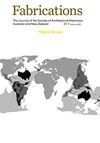Environments of Defence: Finland and the Winter War
IF 0.3
0 ARCHITECTURE
Fabrications-The Journal of the Society of Architectural Historians Australia and New Zealand
Pub Date : 2022-01-02
DOI:10.1080/10331867.2022.2038828
引用次数: 1
Abstract
ABSTRACT In January 1940, the British writer John Langdon-Davies travelled to Finland to report on the Winter War with the Soviet Union (November 1939–March 1940). On his return he wrote a book entitled Finland: the First Total War in which he proposed that it was the ability of the Finnish people to adapt to their environment that enabled the determined defence of their country from forces far greater in number and with superior armaments. His theme originated with the “military science,” as he put it, of collective defensive action that embraced the topography of Finland, its climate, and the skills evolved by life within it. He proposed that since its independence in 1917 and the subsequent civil war, Finland had been designed as a social democracy fit for purpose in its resilience to both political and military threat. Langdon-Davies considered Finnish modern architecture of the 1930s as part of a national strategy that embraced place, cooperation, and social wellbeing. He positioned architecture and design within interconnected military, social and economic contexts, as a kind of expanded functionalism both technical and poetic. This paper argues that Finland: the First Total War contributes to understandings of architecture as a protagonist in national defence.防御环境:芬兰与冬季战争
摘要1940年1月,英国作家约翰·兰登·戴维斯前往芬兰,报道与苏联的冬季战争(1939年11月至1940年3月)。回国后,他写了一本名为《芬兰:第一次全面战争》的书,在书中他提出,正是芬兰人民适应环境的能力,使他们能够坚定地保卫自己的国家,使其免受人数更多、装备精良的部队的袭击。正如他所说,他的主题源于“军事科学”,即集体防御行动,包括芬兰的地形、气候和生活所演变的技能。他提出,自1917年独立和随后的内战以来,芬兰一直被设计成一个社会民主国家,以应对政治和军事威胁。兰登·戴维斯(Langdon Davies)认为,20世纪30年代的芬兰现代建筑是国家战略的一部分,该战略包含了地方、合作和社会福利。他将建筑和设计定位在相互关联的军事、社会和经济背景下,作为一种技术和诗意的扩展功能主义。本文认为,《芬兰:第一次全面战争》有助于理解建筑是国防的主角。
本文章由计算机程序翻译,如有差异,请以英文原文为准。
求助全文
约1分钟内获得全文
求助全文
来源期刊

CiteScore
0.50
自引率
25.00%
发文量
26
 求助内容:
求助内容: 应助结果提醒方式:
应助结果提醒方式:


